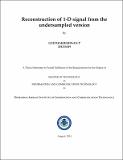| dc.contributor.advisor | Joshi, Manjunath V. | |
| dc.contributor.author | Geethakrishnan, P. | |
| dc.date.accessioned | 2017-06-10T14:41:40Z | |
| dc.date.available | 2017-06-10T14:41:40Z | |
| dc.date.issued | 2014 | |
| dc.identifier.citation | Geethakrishnan, P. (2014). Reconstruction of 1-D signal from the undersampled version. Dhirubhai Ambani Institute of Information and Communication Technology, viii, 59 p. (Acc.No: T00454) | |
| dc.identifier.uri | http://drsr.daiict.ac.in/handle/123456789/491 | |
| dc.description.abstract | In the present era of information the data transmission and data storage are done as per the sampling theorem. The sampling theorem states that a bandlimited signal has to be sampled at a rate two times the maximum frequency contained in the signal in order to maintain intelligibility and good quality while reconstructing the signal from its samples. This will put a limit on to the highest frequency content allowed to be present in the analog signal to be sampled. All the frequencies F>Fs/2 will be distorted while reconstructing the signal from the sampled values. This happens due to the effect of aliasing. One solution to this issue is to increase the sampling rate, but that leads to an overhead of unnecessary samples which lead to a large bandwidth in case of data transmission and a large memory space in case of storage applications. If it is possible to reconstruct the signal back from the undersampled version, it will save a significant amount of bandwidth and storage space. Here, in this thesis different methods are proposed to estimate the original signal from the undersampled version of the same. Given an undersampled test signal and a training set of signals, the original signal is estimated from them. The proposed methods are based on Discrete Cosine Transform
(DCT), Discrete Wavelet Transform (DWT) and Compressive Sensing (CS) theory. The methods which use the transforms need considerable memory space for storing the training signals. In CS based method the signal is reconstructed from the decimated (undersampled) signal itself without using a training set. | |
| dc.publisher | Dhirubhai Ambani Institute of Information and Communication Technology | |
| dc.subject | Undersampled version | |
| dc.subject | Signal | |
| dc.subject | 1-D signal | |
| dc.classification.ddc | 621.382 GEE | |
| dc.title | Reconstruction of 1-D signal from the undersampled version | |
| dc.type | Dissertation | |
| dc.degree | M. Tech | |
| dc.student.id | 201211019 | |
| dc.accession.number | T00454 | |

